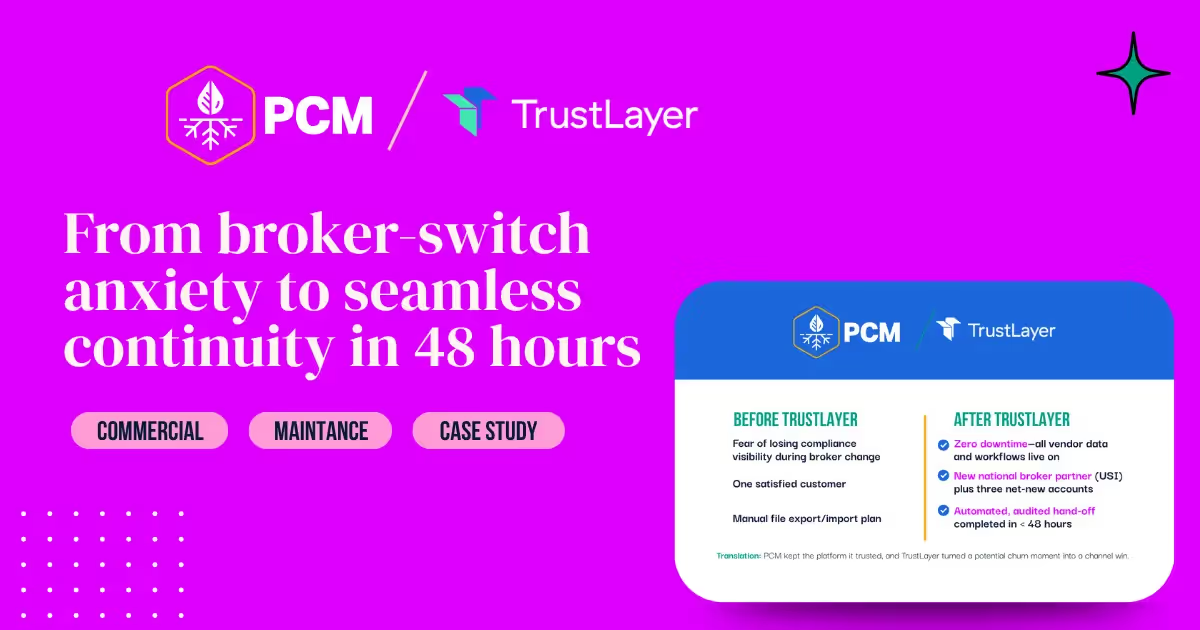The Impact of Digital Proof of Insurance on Compliance Tracking
In today's digital age, the insurance industry is undergoing significant transformations. One notable development is the shift from traditional paper-based proof of insurance to a more efficient and secure digital proof of insurance. This article explores the impact of digital proof of insurance on compliance tracking, highlighting its benefits, challenges, and potential future implications.
Understanding Digital Proof of Insurance
Insurance is a crucial aspect of our lives, providing us with financial protection and peace of mind. Traditionally, individuals and organizations have relied on physical copies of insurance certificates to prove their coverage. However, with the advent of technology, a new form of proof has emerged - digital proof of insurance.
What is Digital Proof of Insurance?
Digital proof of insurance, also known as electronic proof of insurance or e-insurance, refers to the electronic documentation that serves as evidence of an individual or organization's insurance coverage. Instead of carrying physical copies of insurance certificates, policyholders can now access their insurance information through digital platforms, such as websites or mobile applications.
This digital revolution has made it incredibly convenient for policyholders to access their insurance details on the go. No longer do they need to rummage through their wallets or purses to find a crumpled piece of paper. With just a few taps on their smartphones, they can instantly retrieve their insurance information.
Moreover, digital proof of insurance offers enhanced security. Physical documents can be lost, damaged, or even forged. In contrast, digital records are stored securely in databases, protected by encryption and other advanced security measures. This ensures the integrity and authenticity of the insurance information.
The Evolution of Digital Proof of Insurance
The use of digital proof of insurance is a product of technological advancements and changing consumer preferences. Insurance providers have embraced digitalization to enhance customer experience, streamline operations, and enable faster compliance tracking.
In the past, insurance policies were primarily paper-based, requiring policyholders to carry physical copies. This process was often cumbersome and time-consuming, leading to delays in accessing insurance information when needed. However, with the rise of digital platforms, insurance companies have transitioned to providing electronic documentation.
Nowadays, policyholders can conveniently access their insurance policies through user-friendly websites or dedicated mobile applications. These platforms offer a range of features, such as policy summaries, coverage details, and even the ability to file claims online. This digital transformation has revolutionized the insurance industry, making it more accessible and efficient for both policyholders and insurance providers.
Furthermore, digital proof of insurance has enabled insurance companies to streamline their operations and reduce costs. By eliminating the need for printing and mailing physical documents, insurers can save resources and contribute to a more sustainable environment. Additionally, digital records can be easily updated and shared, ensuring that policyholders have the most up-to-date information at all times.
As technology continues to advance, we can expect further innovations in digital proof of insurance. From the integration of blockchain technology for enhanced security to the use of artificial intelligence for personalized policy recommendations, the future of digital insurance holds immense potential.
In conclusion, digital proof of insurance has transformed the way we access and manage our insurance coverage. With its convenience, security, and efficiency, it has become an integral part of the insurance industry. As technology continues to evolve, we can look forward to even more exciting developments in the realm of digital insurance.
The Role of Digital Proof of Insurance in Compliance Tracking
The Importance of Compliance in the Insurance Industry
Compliance is not just a buzzword in the insurance industry; it is a critical aspect that ensures the smooth functioning of the entire ecosystem. Regulatory bodies establish guidelines to ensure that insurers adhere to industry standards, protect policyholders' interests, and mitigate risks. These regulations are put in place to maintain a level playing field, prevent fraud, and promote fair competition.
Insurance companies are entrusted with the responsibility of managing risks and providing financial protection to policyholders. Compliance tracking plays a pivotal role in ensuring that insurers fulfill their obligations and operate within the boundaries set by the regulatory authorities.
How Digital Proof Facilitates Compliance Tracking
In this digital age, technology has revolutionized various industries, and the insurance sector is no exception. One significant advancement is the introduction of digital proof of insurance, which simplifies compliance tracking for all stakeholders involved.
Insurance providers can leverage digital platforms to automate policy verification processes, reducing the time and effort required for manual checks. Gone are the days when policyholders had to carry around physical insurance cards or documents. With digital proof of insurance, policyholders can conveniently access their insurance information through mobile apps or online portals. This not only enhances customer experience but also ensures that policyholders have their insurance information readily available whenever needed.
Moreover, digital proof of insurance allows insurers to streamline their operations and improve efficiency. By eliminating the need for manual verification, insurers can allocate their resources more effectively, focusing on other critical aspects of their business. This not only saves time but also reduces the chances of errors or discrepancies that may arise during manual checks.
Regulators also benefit from digital proof of insurance as it enables them to access real-time data through digital systems. This real-time data empowers regulators to proactively monitor compliance and identify any potential issues or non-compliance promptly. By having access to up-to-date information, regulatory bodies can take necessary actions swiftly, ensuring that insurers are operating within the legal framework.
Furthermore, digital proof of insurance enhances transparency and accountability in the insurance industry. With digital records, it becomes easier to track and trace insurance policies, ensuring that all parties involved comply with legal requirements. This not only protects policyholders but also promotes trust and confidence in the insurance industry as a whole.
In conclusion, digital proof of insurance has revolutionized compliance tracking in the insurance industry. It simplifies the verification process, enhances efficiency, and enables real-time monitoring of compliance. As technology continues to advance, digital proof of insurance will undoubtedly play an even more significant role in ensuring a compliant and trustworthy insurance ecosystem.
Benefits of Digital Proof of Insurance in Compliance
When it comes to compliance tracking, the adoption of digital proof of insurance brings about a plethora of benefits that cannot be overlooked. Let's delve into some of the key advantages:
Increased Efficiency in Compliance Tracking
The traditional method of compliance tracking involves manual processes, which can be time-consuming and prone to errors. However, with the introduction of digital proof of insurance, the efficiency of compliance tracking has significantly improved. Insurance providers now have instant access to information and automated verification processes, allowing them to expedite compliance checks and reduce administrative burdens.
Imagine a scenario where insurance providers had to sift through stacks of paper documents to verify compliance. It would not only be a tedious task but also leave room for human error. With digital proof of insurance, this streamlined approach saves time and allows for more accurate and reliable tracking.
Improved Accuracy and Transparency
One of the major advantages of digital proof of insurance is the enhanced accuracy and transparency it provides. Unlike paper documents that can be easily lost, damaged, or forged, digital records are securely stored and easily accessible. This ensures that accurate policy information is readily available for compliance tracking purposes.
Imagine a situation where an insurance provider needs to verify a policy's details for compliance purposes. With digital proof of insurance, they can effortlessly access the necessary information with just a few clicks. This minimizes the chances of errors and fraudulent activities, as the data is securely stored and cannot be tampered with.
Furthermore, the transparency offered by digital proof of insurance is invaluable. Insurance providers can easily track and monitor policy compliance, ensuring that all necessary requirements are met. This not only helps in maintaining regulatory compliance but also builds trust and confidence among stakeholders.
In conclusion, the benefits of digital proof of insurance in compliance are undeniable. The increased efficiency in compliance tracking and improved accuracy and transparency are just a few of the advantages that insurance providers can enjoy. By embracing digitalization, the insurance industry can revolutionize compliance processes and pave the way for a more secure and reliable future.
Challenges in Implementing Digital Proof of Insurance
Digital proof of insurance offers numerous benefits, but its implementation can be hindered by various challenges. In addition to the technological barriers, there are also regulatory and legal considerations that need to be addressed.
Technological Barriers
One of the primary challenges in implementing digital proof of insurance is the need for proper infrastructure and technological upgrades. Insurance companies must invest in robust cybersecurity measures to ensure the protection of policyholders' data. This includes implementing encryption protocols, firewalls, and other security measures to prevent unauthorized access.
Compatibility with existing systems is another technological barrier that insurance companies face. Integrating digital platforms with legacy systems can be complex and time-consuming. It requires thorough testing and customization to ensure seamless data transfer and synchronization between different systems.
Moreover, the adoption of digital tools necessitates employee training. Insurance companies need to provide comprehensive training programs to their staff to ensure they can effectively navigate and utilize these digital platforms. This includes educating employees on the use of digital proof of insurance applications, data entry protocols, and troubleshooting common issues.
Regulatory and Legal Considerations
Implementing digital proof of insurance also raises regulatory and legal considerations that must be carefully addressed. Insurers must ensure compliance with data privacy laws and regulations when storing and sharing policyholders' information electronically. This involves implementing strict data protection measures and obtaining the necessary consent from policyholders to handle their data digitally.
Additionally, industry regulators need to establish guidelines to address the validity and acceptance of digital proofs across different jurisdictions. Since insurance regulations can vary from one region to another, it is crucial to establish a standardized framework that ensures the acceptance of digital proofs of insurance across all jurisdictions. This requires collaboration between insurance companies, regulators, and government entities to develop a unified approach.
Furthermore, legal considerations come into play when implementing digital proof of insurance. Insurance policies and contracts may need to be revised to include specific clauses related to digital proof acceptance and usage. This ensures that policyholders are aware of the digital proof option and its legal validity.
In conclusion, while digital proof of insurance offers numerous benefits, its implementation is not without challenges. Technological barriers, such as infrastructure, cybersecurity, and compatibility, must be overcome. Additionally, regulatory and legal considerations need to be carefully addressed to ensure compliance and acceptance of digital proofs across different jurisdictions. By addressing these challenges, the insurance industry can unlock the full potential of digital proof of insurance and provide a more convenient and efficient experience for policyholders.
The Future of Compliance Tracking with Digital Proof of Insurance
The future of compliance tracking in the insurance industry lies in further advancements in digital proof of insurance. One emerging trend is the integration of blockchain technology, which can enhance data security, privacy, and immutable proof of insurance. Blockchain technology, known for its decentralized and transparent nature, has the potential to revolutionize compliance tracking by providing a tamper-proof and verifiable record of insurance policies.
With the use of blockchain, insurance companies can ensure that policyholders' information is securely stored and easily accessible. The decentralized nature of blockchain eliminates the need for intermediaries, reducing the risk of fraud and improving the efficiency of compliance tracking processes. Additionally, blockchain technology can enable real-time updates to insurance policies, ensuring that policyholders have the most up-to-date information at all times.
Another emerging trend in digital proof of insurance is the utilization of Artificial Intelligence (AI) and machine learning algorithms. These technologies can automate compliance tracking processes, enabling proactive identification of potential risks. AI-powered systems can analyze large volumes of data, such as policy documents and claims history, to identify patterns and anomalies that may indicate non-compliance or fraudulent activities.
Potential Impact on Insurance Industry and Policyholders
The widespread adoption of digital proof of insurance has the potential to revolutionize the insurance industry and benefits both insurance providers and policyholders. Insurance companies can achieve cost savings, improved operational efficiency, and enhanced fraud detection. By leveraging blockchain technology, insurers can streamline their compliance tracking processes, reducing the need for manual verification and paperwork.
Policyholders, on the other hand, can enjoy convenient access to their insurance information, faster claims processing, and improved customer experience. With digital proof of insurance, policyholders no longer need to carry physical copies of their insurance documents. Instead, they can access their policies through secure online platforms or mobile applications, ensuring that their insurance information is always at their fingertips.
In addition to convenience, digital proof of insurance can also expedite the claims process. Insurance companies can use AI-powered systems to automatically verify policy information and process claims more efficiently. This reduces the time and effort required for policyholders to file and track their claims, resulting in faster payouts and a smoother claims experience.
Moreover, the transparency and immutability provided by blockchain technology can help prevent insurance fraud. By storing policy information on a decentralized ledger, insurers can ensure that policyholders' information is secure and cannot be tampered with. This enhances trust between insurers and policyholders, as well as reduces the risk of fraudulent claims.
Overall, the adoption of digital proof of insurance brings numerous benefits to both insurance providers and policyholders. Insurance companies can streamline their compliance tracking processes, reduce costs, and improve fraud detection, while policyholders can enjoy convenient access to their insurance information, faster claims processing, and enhanced customer experience.
In conclusion, the utilization of digital proof of insurance marks a significant shift in compliance tracking within the insurance industry. Its numerous benefits, including increased efficiency, improved accuracy, and transparency, highlight its relevance in today's digital landscape. While challenges exist, ongoing advancements and emerging trends, such as blockchain technology and AI-powered systems, will continue to shape the future of compliance tracking with digital proof of insurance. As the industry evolves, forward-thinking organizations like TrustLayer are leading the way, providing innovative solutions to overcome these challenges and ensure seamless compliance tracking in the digital era.
















